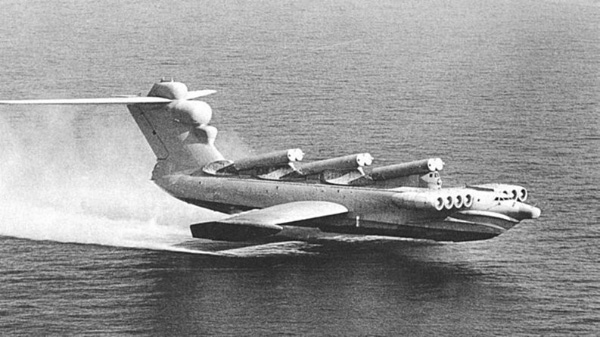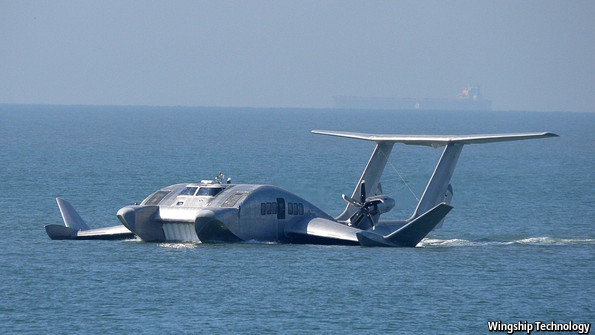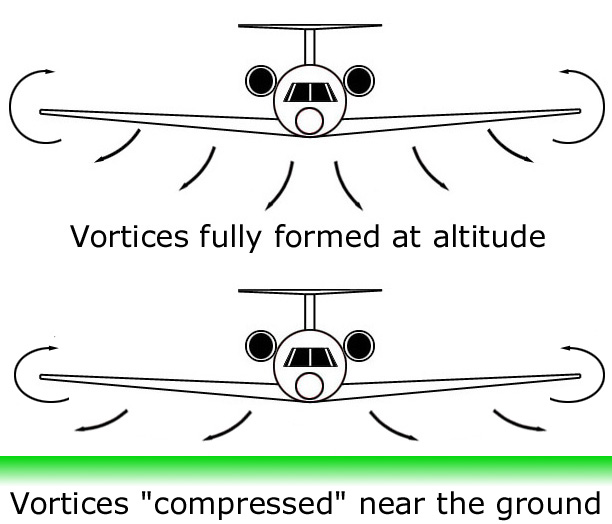Ground effect (aircraft)
As ground effect is called a physical phenomenon, drawing a flow around the body near the ground. This can result depending on the shape of the body in flow, additional dynamic lift or downforce.
Principle
The air gap between the wing trailing edge, and the bottom is the smaller, the smaller the distance from the ground. The air is dammed and slowed the flow under the whole wing. Characterized where the pressure rises, which leads to a larger dynamic lift. At the same time the center of lift moves backwards. The ground effect is therefore based on that forms an air cushion under the wing near the ground, which deals with the vehicle (aircraft) moved forward. Here, the lift - drag ratio increases with proximity to the ground on the 2.5 - 3 fold - up. So there is an improvement in the efficiency of a wing, and thus more buoyant.
Fluidically considered can the ground effect described as follows: The pressure distribution on the profile changes and leads to a reduction in induced drag. The resistance of the wing is composed of the frictional resistance, the pressure resistance and the induced drag. This is caused by the vortices at the wing tips, which are formed by the pressure balance between the top and bottom.
This creates a vortex behind the wing band and tip vortices, which accelerate the air behind the wing down. The situation created by this pressure force acts perpendicular to the velocity vector. This results in addition to the lift or a direction of movement opposing force, the induced drag. Near the bottom is hardly any space for air to flow down and she is forced to flow away almost horizontal. So that the induced drag decreases. Thus, energy is required to overcome induced drag can be saved.
The effect was observed in 1880 by Gustav Lilienthal at the Albatros, but not understood, but already recognized at the beginning of aviation in the early 20th century.
Examples of the ground effect
Wing aircraft
Near the ground, the aerodynamics of wings change. The buoyancy is larger, the buoyancy center of gravity moves to the rear and the air resistance becomes smaller. When flying with a low-wing close to the ground the ground effect causes the aircraft hovers much longer than is the case for example in a high-wing aircraft. This must be a pilot when landing with low- deckers, pay particular attention to short runways.
In ground effect vehicles ( Ekranoplan ) is mostly seaplanes, which are designed for low-altitude flight taking advantage of the ground effect and are therefore only suitable for certain applications. Ground effect vehicles can both be fixed-wing aircraft that are airworthy for larger heights. On the other hand, ground effect vehicles will be administratively managed as ships, when the low altitude ground effect vehicles forcing the traffic network to interact with ships and boats, so to submit to the maritime law. For this reason, these devices are also called ground effect " vehicles " and not ground effect " aircraft ", although it physically seen aircraft are flying (dynamic lift aircraft) and do not drive (static buoyancy, airships ). Gliders can in ground effect under lower altitude loss a much further distance than to cover the corresponding glide angle. This is often used by glider pilots to the final landing to hovering closely above the entire place to go in the evening by plane to the parking hall.
The largest ever built " aircraft," the Hughes H-4, resulted from only one test flight in 20m height. The ability to fly out of ground effect is therefore questionable.
Rule of thumb: The floor effect occurs when the flying height is equal to or less than half the wing span of the wing.
Helicopter
In terms of reference of helicopters you can find the terms HIGE ( for hovering in ground effect ) and HOGE ( for hovering out of ground effect ). These expressions are typically used when reporting on the work limits of helicopters based on the required motor power. Just as with the wings of airplanes, there are helicopters in a ground effect near the ground, which is as a result of interaction of the downward air flow of the main rotor to the ground for increased buoyancy responsible. Air falls from above into the rotor disk, is accelerated downward and impinges on the floor. Since the soil prevents the air at a rapid outflow, the helicopter is also raised. At the same time there is a reduction of rotor tip vortices.
The floor effect in helicopters occurs when the helicopter is ( HIGE ) within a half to a full rotor span above ground. It is less effective on water and tall grass, as these surfaces act to absorb energy, and he is not present when the helicopter is moving at a higher altitude ( HOGE ). The latter necessarily mean a higher power requirement and greater fuel consumption.
The ground effect has for working limits of helicopters quite a meaning. If you have to start with limiting factors such as heavy objects, lifting it from an elevated place or at high temperature, the ground effect extend through the addition supplied buoyancy force this work boundaries, thus enabling the lifting in some cases in the first place.
For model helicopters to be flown in a room close to the ceiling, the same effect in reverse occurs: The helicopter is formally of her "dressed" from a certain approximation to the ceiling. This effect would also occur in real helicopters, if you were flying on a ceiling close enough.
Ground effect vehicles by the ram-wing principle
A special design of a ground effect vehicle according to the dynamic wing principle is a Tandem Airfoil Flairboat. The tandem wing principle leads to an inherent stability is achieved during ground effect flight, which guarantees secure flair state within the ground effect. An exit of the ground effect, as it is achieved in the free-flight performance ground effect vehicles, this is not intended.
The fact that a Tandem Airfoil Flairboat the ground effect can not leave already led in 1974 to the transport engineering and regulatory technical classification as a ground effect vehicle type A.
Due to the classification as WIG craft Type A tandem Airfoil Flairboat is classified as a vessel, so that a motor boat license for the operation is sufficient.
Land vehicles
An application of the ground effect can be found in motorsport. From the ground up designed for very fast race cars, such as Formula 1, have low ground clearance not only because of the favorable center of mass. In 1977, a team Lotus, not possible just to carry out the floor, but also to direct additional air at the vehicle, in particular to take advantage of the ground effect. The entire page body of the Lotus 78 were formed as an inverted wing and outside largely sealed by Aprons, almost touching the road. The pressure increased enormously without the flow resistance increased, but already vanished when driving over the curbs dangerous. Since the 1983 season the rules of Formula 1 require a consistent ground clearance of several centimeters to limit the floor effect.










